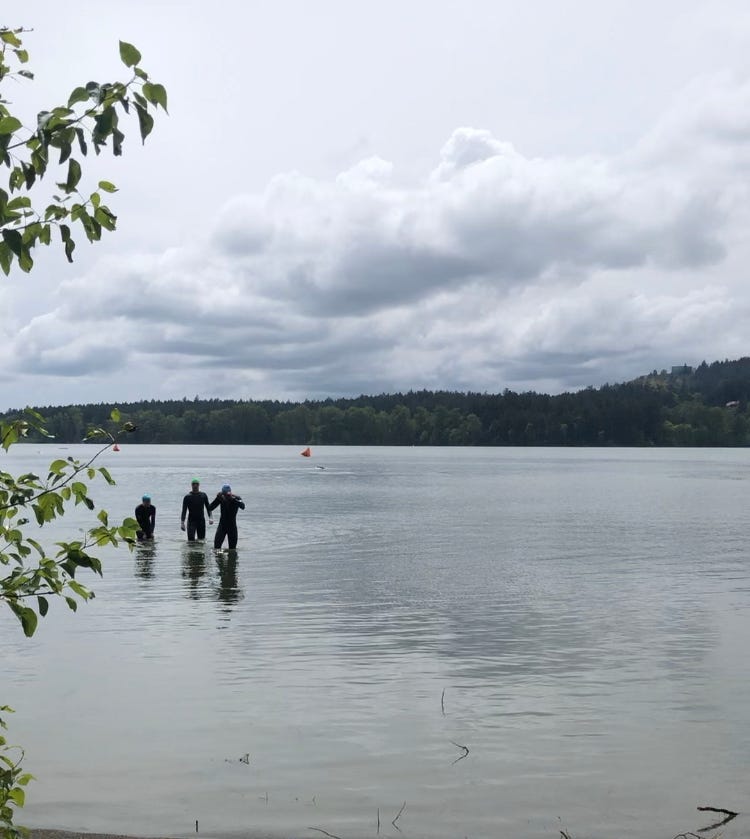#1 (Prologue): Tears and fears at the back of the swim-start in the 70.3 Ironman triathlon, Victoria, May 2022.
Lining up with the weak, the stoic, and the possibly hungover.
I am standing at the very back of the swim chute for my first half-Ironman, behind 1900 other racers who have lined up according to their estimated swim-finish times, when I become aware of a young woman in a wetsuit standing just outside the participant barrier, crying.
A man who might be her boyfriend tries to put his arm around her, but it doesn’t help.
I’m struck by how continuously and how silently she sobs without bothering to hide her face. I admire her seeming lack of embarrassment. She has enough to worry about, starting with the 1.2-mile swim ahead, in a lake that was so cold until last week that there was a good chance the whole event would be canceled. At least from a distance, she seems to be skipping the extra step of worrying about what anyone else thinks about her.
Finally, she leaves her worried boyfriend behind the barrier and enters the line, just ahead of me. Two women who have been chatting giddily notice the woman’s distress and introduce themselves, trying to cheer her out of what seems to be a panic attack. One puts an arm around her.
I look on enviously from behind, wishing I could be in their friendly girls’ group, but I don’t fit. I’m older for one thing, by at least two decades. My attempt to join their banter and bemoan our cold bare feet together gained no traction, even before the sobbing woman distracted us all.

The only other people in our back-of-the-pack cluster are two women—one who admits she can’t swim crawl, only breaststroke, and a woman who already admitted she doesn’t plan to race the entire 70.3, as this event is called due to its combined mileages. (1.2-mile swim, 56-mile bike, 13.1-mile run.)
The latter woman hasn’t trained enough, she tells me. Her male partner is far ahead of her, with the faster competitors. She is going to do the swim and then skip the rest—or perhaps she decides to skip all of it because some moments later I turn and can’t find her anywhere.
That leaves two guys who have slinked from the nearest road into the very back of the line, wearing baggy, ill-fitting wetsuits.
“Is this the smoking section?” one of the guys jokes.
They seem nervous. When I try to ask the closest one if he has swum this distance before, he says he doesn’t know.
“Have you trained in open water?”
“Nah,” he says, chuckling and glancing over at his heavier friend.
“Have you done laps in a pool?”
“Some.”
“But this distance?”
“I don’t know.”
I get the sense these two guys, the only ones who are further back from the start than I am, are attempting this race as a wager or a joke. They look like they might have hangovers. My banter isn’t helping them find the party vibe they’re looking for. After a few minutes of hopping from foot to foot, trying to warm up in the cool dawn air, they ease past me, to stand closer to the young women.
Briefly, I was third-to-last in line. Now that the party dudes have passed me, I’m absolutely last-in-line. I would stand even further back if it were possible, but my actual “estimated swim time” isn’t even listed on a sign.
If I swam any slower than I do, I wouldn’t be able to compete at all. There is a very good chance, if I can’t pick up my typical pace, that I’ll be eliminated. Seventh months of training will have been for naught. Just let me finish, I think. Don’t panic during the swim. Don’t require a rescue. Just finish in time to be allowed to bike and run. That’s more than enough.
And yet, like the woman who is still sobbing even twenty minutes later, and like the woman who has already decided not to participate in all three stages of the race, and perhaps also like the woman who can only swim breaststroke, I have my doubts.
The gender differences at the back of the line are, for me, a stark reminder of how women and men—not all, but some—face a challenge like this differently. The women closest to the back express their vulnerabilities openly. One is terrified. One is cautious, hanging back so she doesn’t get in anyone’s way. One doesn’t even plan to finish. By contrast, the two men who look less fit and more haggard than anyone else bluster their way forward, unwilling to admit that competing without training may be asking for trouble.
Would I want to be like those men, who don’t feel the need to admit they are at the edge of their capabilities?
Is there a way to be confident and realistic at the same time—equally ready for success and ready for the very likely chance of failure?
What would I try, if I were not so limited by the anxious part of my brain?
Who would I be, if I knew how to contain or conquer my fear better?
And yet, in one way, I am learning to conquer my fear. I am here, just as the crying woman is. Many times over the last months of training, I have admitted that I don’t think I can do this thing. But since waking at 4 AM today, I’ve given not a single thought to backing out. There is immense relief that comes from ending the negotiation.
We shuffle forward, closer to the lake, where triangular floating buoys marking the route at 100-meter intervals extend farther than the eye can see. There’s no turning back.

